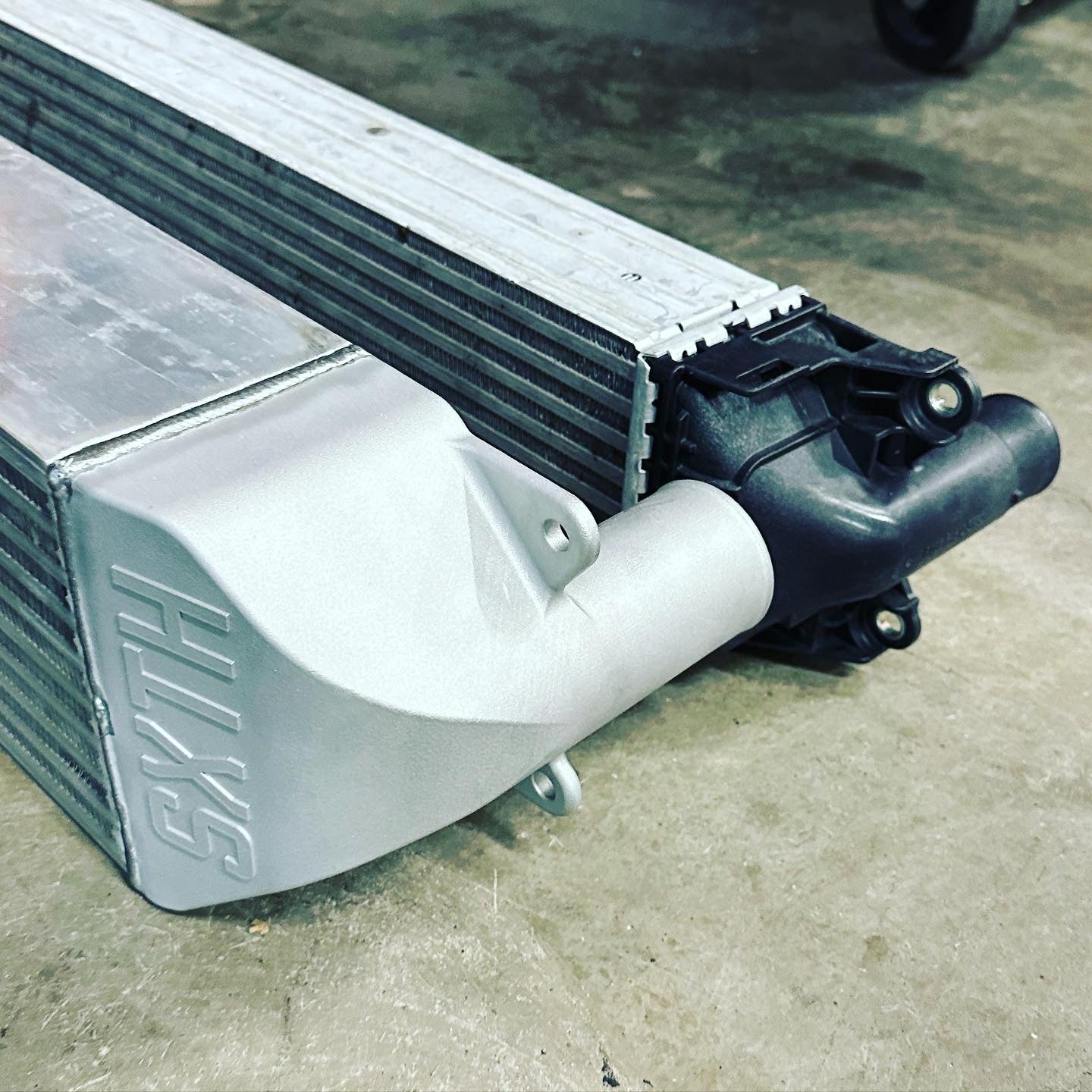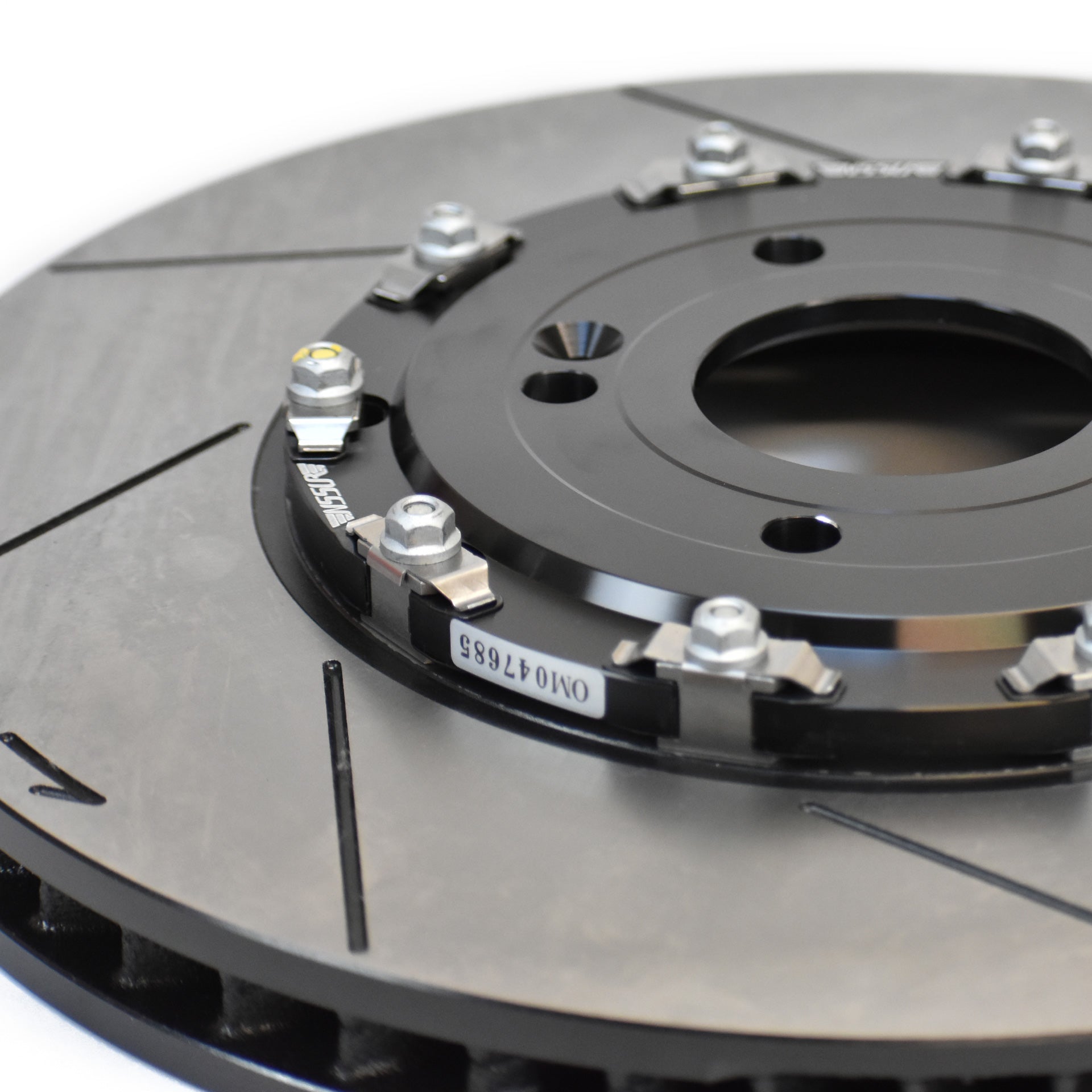We're back with our Intercooler testing! Our first core didn't perform as expected, so we went back to the drawing board. The 2nd design had us increasing core size and adjusting the boost airflow paths. The results were exactly as we had hoped, with peak gains between 16-17whp and up to 20whp in the upper rpms.
Here is an overview of the difference between OEM and SXTH.
OEM Dimensions:
- 24.7in by 5.7in by 3.16in core
- 1.75in inlet/outlet diameter
- 9 boost air rows
SXTH Dimensions:
- 23in by 6.8in by 4.2in core
- 2.25in inlet/outlet diameter
- 10 boost air row
As you can see with these characteristics, the SXTH core flows significantly more and has more room for better heat exchanging. You'll see that as we compare temperature datalogs.
With our goal of a bolt-on kit with no cutting (like current GR Yaris Intercooler installations/conversions), we 3D scanned the car to maximize core dimensions within the available space. Our core was then designed in CAD to achieve maximum core dimensions while shaped for smooth airflow.

Our intercooler comes with new hoses/clamps to adapt to the OEM charge pipes. We are in the midst of creating larger charge pipes, as the OEM ones are very small for this power level. 
Now let's dive into the good stuff, the testing data! We'll start with the road test driving. Below is a thermometer datalog of the OEM intercooler, with thermometers places in the hot side end tank and cold side end tank.
- T1 is intercooler hot side temperature
- T2 is intercooler cold side temperature
- Each massive spike in T1 is wide open throttle with full boost
- Notice the spikes in T2 correlate with T1

Looking the the OEM log above, you can see boosted air temp spikes reach 120 degF in the first couple pulls. Then flooring it again a little later makes them climb to 140 degF!
Now let's look at the SXTH log, taken on the same driving route later that same day, with wide open throttle pulls made in approx the same areas for the same amount of time.

Looking at the SXTH log above, you can see it takes a lot longer to even soak this core, much less getting temps even close to OEM. Boosted air temps barely passed 120 degF when the OEM core was pushing over 140!
The larger, better flowing core is showing a minimum of 20 DegF temp drop on the street, even in hotter ambient conditions later in the day.
Now, let's perform the same temp test log on the dyno.
We ran the GR Corolla on the dyno with the OEM core installed, then we did the intercooler swap and ran it again that afternoon.
Here is the overview of the testing:
- OEM tuning, no piggyback or flash tune!
- The car is 100% stock for both runs, except for our single exit catback prototype (installed on both runs)
- 2WD dyno mode used, per factory service manual (remove driveshaft/awd fuse)
- Initial pulls for each intercooler test had oil/coolant temps of 190 DegF
- Each intercooler had 3 runs, back to back with approx 60-90 seconds between runs
- Runs made in 4th gear
***AS SAID IN OUR INTAKE TEST POST, WE ARE ONLY INTERESTED IN THE GAINS BEFORE AND AFTER THE SWAP OF THE INTERCOOLER. DO NOT GET HUNG UP ON THE OVERALL NUMBERS, THEY ARE IRELLEVANT TO THE TEST AND SPECIFIC TO OUR DYNOJET AND DRIVE WHEELS USED***
Before we get into the dyno charts, let's look at the temp logs of the dyno runs. Here is the OEM core below. The 3 spikes of T1 are the 3 wide open throttle pulls. Notice how T2 gets hotter the more you run it. Boosted air temps go from 140 DegF in the first pull to 160 DegF in the next 2 pulls!

Now look at the SXTH dyno runs below. You can see boosted air temps are much lower with the higher flowing core!

Now that you can see how much cooler the air system is overall, here is where you can see that translation into power. Below are all 6 dyno runs overlaid with one another. Looking at the run listing, here is a quick explanation:
- RunFile_0 is the first OEM Intercooler run (Red)
- RunFile_1 is the second OEM Intercooler run (Blue)
- RunFile_2 is the third OEM Intercooler run (Green)
- RunFile_3 is the first SXTH Intercooler run (Yellow)
- RunFile_4 is the second SXTH Intercooler run (Navy Blue)
- RunFile_5 is the third SXTH Intercooler run (Brown)

There are a lot of lines to look at there. So let's break those down into direct comparisons. Here is the first OEM run vs the first SXTH run below.

Look at that! 18whp peak gains right off the rip with upwards of 21 in the higher RPMs!
Well, the more you run things, the hotter everything gets, which means power suffers. Let's look at run 2 for both cores together below.

As you can see here again, power is consistently gained throughout, around 13whp to 17whp. Lastly, let's look at the 3rd, hottest runs for both cores below.

You can see above the SXTH core is still exchanging heat efficiently, sustaining 14+whp gains throughout the powerband!
Something else to point out, you can also see the SXTH tests show lower T1, despite doing those runs in the warmer part of the afternoon. If everything else being the same (parts and the tune) being the same, why the change?
SIMPLE! PRESSURE!
Since our core flows more air with larger and more air channels, this introduces a pressure drop within the closed system between the turbo and the engine.
Well then, how do you know this for sure? 20-30 degrees is a big difference. That is true, that is a big difference in temp, but as you are about to see it doesn't take much.
This is where Gay-Lussac’s Law comes into place. This simply states a gas's pressure is directly proportional to it's temperature. Let's do some simple math and see what's going on here.
For this law, pressures can be in any unit, but temperature must be used in Kelvin units. We do not know pre-intercooler pressure, so for arguments sake let's use the peak boost pressure advertised at 25.2 psi. For temperatures pre-intercooler, let's use the 2nd power pull in each dyno test.
For the OEM dyno test, we see about 310 degrees F, or 427.6 Kelvin.
For the SXTH dyno test, we see 280 degrees F or 410.9 Kelvin.
The law states P1/T1 = P2/T2 where:
P1 = 25.2 psi
T1 = 427.6 Kelvin
P2 = ?
T2 = 410.9 Kelvin
Solving for P2, you get P2 = 24.2 psi
Crazy right? A simple psi of pressure drop within the system results in pretty drastic pre-intercooler boosted air temps and an overall cooler system.
These are going into production immediately with pricing and availability to be announced ASAP. Thanks for the support, we appreciate it!




Comments
What happens if you run this intercooler without a tune? Will the pressure drop cause the turbo to work harder?
Is your intercooler a direct replacement fit ?? Or is ther trimming/cutting involved?? I am hoping to find a intercooler for my GR Corolla that I don’t have to cut the car apart or custom it to fit ??
No doubt that your IC works better, but the T1 temps in the second dyno graph are 20-30 degrees lower than the OEM test, so TQ2 would be proportionally lower. Might want more consistent before/after conditions if you run it again.
I’m interested